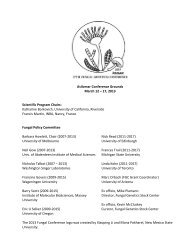Asperfest 4 Program - Fungal Genetics Stock Center
Asperfest 4 Program - Fungal Genetics Stock Center
Asperfest 4 Program - Fungal Genetics Stock Center
Create successful ePaper yourself
Turn your PDF publications into a flip-book with our unique Google optimized e-Paper software.
3. Characterization of Protein O-mannosyltransferases in Aspergillus nidulans. Thanyanuch Kriangkripipat and Michelle<br />
Momany* Department of Plant Biology, University of Georgia, Athens, Georgia 30602 USA tkriang@plantbio.uga.edu<br />
Protein O-mannosyltransferases (PMTs) are found in bacteria, fungi, and animals but are not present in plants. In fungi, PMTs are<br />
divided into three subfamilies, PMT1, PMT2 and PMT4 and each species has 3-7 PMTs. Aspergillus nidulans possesses three PMTs,<br />
Pmt1, Pmt2 and Pmt4. Single pmt deletion mutants are viable. Each Äpmt mutant exhibits different phenotypes when characterized<br />
by growth at different temperatures, morphology and sensitivity to chemicals disturbing cell wall synthesis. Double mutants show<br />
O<br />
additive phenotypes. The Äpmt1 mutant has hyphal tip lysis and produces aberrant conidiophores at 42 C. The Äpmt2 mutant cannot<br />
O<br />
O<br />
send out germ tubes at 42 C. The Äpmt4 mutant has swollen hyphae and produces aberrant conidiophores at 42 C. The Äpmt1Äpmt2<br />
double mutant is viable and has additive phenotypes of Äpmt1 mutant and Äpmt2 mutant. The Äpmt2Äpmt4 double mutant is viable<br />
but very sick and forms a microcolony only when an osmotic stabilizer is added to the medium. Lower temperatures and osmoticum<br />
can partially restore wildtype hyphal growth and conidiation of these Äpmt mutants except for the Äpmt2Äpmt4 double mutant. Our<br />
results suggest that protein O-mannosylation is important for cell wall integrity of A. nidulans.<br />
4. Characterization of the Aspergillus nidulans septin mutant ÄaspB/cdc3. Yainitza Rodriguez and Michelle Momany Department<br />
of Plant Biology, University of Georgia, Athens, Georgia 30602 USA yrodriguez@plantbio.uga.edu<br />
Septins are filament forming P-loop GTPases found in microsporidia, fungi and animals. Septins play important roles in a variety<br />
of processes such as cellular and nuclear division, membrane trafficking and organization of the cytoskeleton. This family of proteins<br />
was first discovered in a screen for temperature sensitive cell cycle mutants in Saccharomyces cerevisiae. In yeast, septins form<br />
filamentous rings at the mother-bud neck which are necessary for completion of cytokinesis and normal morphogenesis. In Aspergillus<br />
nidulans there are five septins aspA/cdc11, aspB/cdc3, aspC/cdc12, aspD/cdc10, and aspE. The A. nidulans septin aspB/cdc3 was<br />
previously shown to localize at septation and branching sites and at interface layers of the conidiophore. This gene was reported to<br />
be essential. We have now found that deletion of aspB/cdc3 is not lethal, but causes severe defects in asexual reproduction and<br />
aberrant morphology in several developmental stages. The mutant shows emergence of multiple germ tubes, hyperbranching and<br />
hooked branches and disorganized conidiophores. ÄaspB/cdc3 also shows sensitivity to calcoflour, but not benomyl or cytochalasin<br />
A, which suggests that the mutant phenotype is not directly associated with the actin or microtubule cytoskeleton, but perhaps with<br />
cell wall stability.<br />
5. The Nuclear Migration Protein NUDF Associates with BNFA and NUDC at Spindle Pole Bodies in Aspergillus<br />
nidulans. Kerstin Helmstaedt, Karen Meng, Silke Busch, Özgür Bayram, Oliver Valerius and Gerhard H. Braus. Institut für<br />
Mikrobiologie und Genetik, Georg-August-Universität Göttingen, Grisebachstr. 8, D-37077 Göttingen, Germany. Tel. +49-551-<br />
3919693, Fax +49-551-393820, khelmst@gwdg.de<br />
In A. nidulans, nuclear migration depends on microtubuli, the motor dynein and nuclear distribution proteins like NUDF. Applying<br />
tandem affinity purification, we isolated a unique NUDF-associated protein, which we named BNFA (Binding of NUDF). An A.<br />
nidulans bnfA deletion strain did not show a nud phenotype indicating that a protein with redundant function might exist. A GFP-<br />
BNFA fusion localized to spindle pole bodies (SPBs) throughout the cell cycle. This position depended on NUDF, since in a nudF6<br />
strain BNFA localized mainly to dots in the cytoplasm. In a yeast two-hybrid screen using BNFA as bait, we found that BNFA is a<br />
dimer and that a link might exist to the septation signalling pathway. In a candidate approach, we analysed the putative NUDC-NUDF<br />
interaction in A. nidulans. Although NUDC-GFP alone was localized to immobile dots at the cortex, we found a direct interaction<br />
between NUDF and NUDC in yeast two-hybrid experiments, which depended on NUDF's WD40 domain. Applying bimolecular<br />
fluorescence complementation microscopy, we showed that in vivo NUDF and NUDC interact also at spindle pole bodies throughout<br />
the cell cycle and at immobile dots at the cortex.<br />
4th International Aspergillus Meeting 6 Poster Abstracts











